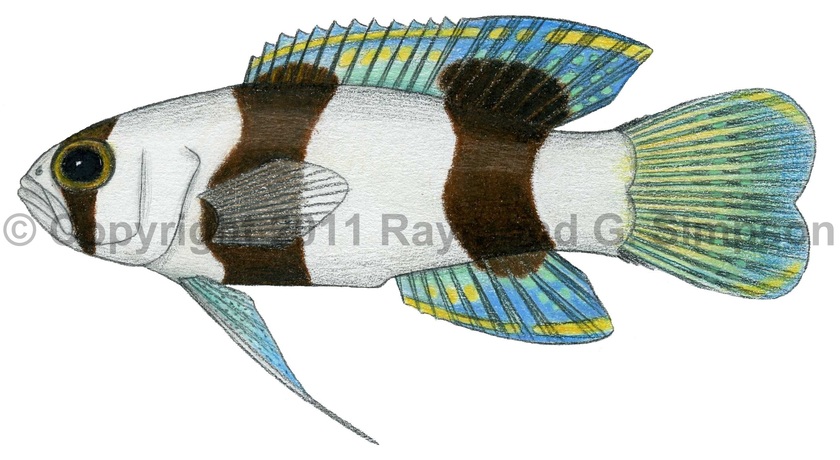
Common Name
Hourglass Basslet
Year Described
Baldwin, Nonaka, & Robertson, 2016
Identification
Dorsal Fin: XII, 9
Anal Fin: III, 8
Pelvic Fin: I, 5
Pectoral Fin: 16-18 (usually 17)
Caudal Rays: 17 (principal)
Gill Rakers: 17-20 total (usually 18-19)
Vertebrae: 10 precaudal, 15 caudal; 25 total
Lateral Scale Rows: ~23
Body stout with blunt snout. Three supraorbital pores; one pore on rear margin of orbit. Lateral line absent. Preopercular margin smooth. Pelvic fin extends well past anal fin origin when depressed. Outer procurrent caudal rays thickened (3 ventrally and dorsally). Caudal fin with rounded lobes.
Color
Body white with three dark brown bands on head and body, broadest in juveniles. The first band passes through eye, the second is hourglass shaped and passes from the dorsal to pelvic region, and the third from the rear dorsal to the rear anal fin. The part of the third band on the soft dorsal and anal fin is darker, almost black. Dorsal fin yellowish with blue markings basally, grading to all blue, followed by a submarginal yellow stripe, and finally a blue fin margin. Bright turquoise spots near the third bar on both anal and dorsal fins. anal fin blue with a yellow submarginal stripe. Pelvic fin yellow with blue margins, and black speckles. Tail yellowish with blue posteriorly, often with turquoise spots along fin rays. Eye yellowish with blue markings.
Size
Maximum size to 28.3mm SL
Habitat
Deep reefs and areas of rocky rubble from 108-154m.
Range
Scattered records in the Caribbean Sea: Bahamas, Bonaire, Curacao, Dominica, Cuba, Mexico, Belize, Honduras, Nicaragua, Jamaica, and Barbuda.
References
Baldwin, C.C., D.R. Robertson, A. Nonaka & L. Tornabene. 2016. Two new deep-reef basslets (Teleostei, Grammatidae, Lipogramma), with comments on the eco-evoluntionary relationships of the genus. ZooKeys No. 638: 45-82.
Other Notes
Confused for many years with juveniles of Lipogramma evides living in deeper water, but morphological and genetic evidence shows it is deeply divergent (17% at CO1 locus) (Baldwin et al., 2016). It has distinctly thicker body bands at all sizes, while L. haberorum and L. evides have thinner forward bands and poorly developed rear bands.